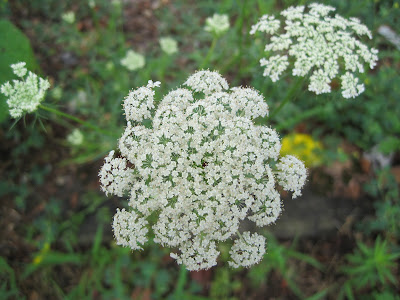When it is something you enjoy in your garden.
The dictionary definition of a weed is: a plant considered undesirable, unattractive, or troublesome, especially one growing where it is not wanted, as in a garden.
So, in essence, a weed is something you don't want. And technically speaking, Queen Anne's Lace is considered among many social circles to be a weed. But look at it! The flower is actually quite beautiful and truly resembles a bit of lace. I've seen it as a companion plant in cottage style gardens or a wildflower setting where it fits in quite well. The wispy foliage, tall slender stems and white flower heads that sway in the breeze are charming in the right place.
Another common weed is Chicory with its blue flowers on slender stems. You can normally find this along the roadside, in parking lots or any deserted area.
It is actually has a beautiful blue flower and looks quite pretty on its own. In fact, I just happened to drive by a house in the neighborhood that had a Chicory "shrub" growing next to the driveway as if it were an ornamental plant:
And the thistle. Scotland's national flower. Prickly and scary looking, but somehow handsome and strong with the spiky green foliage and purple-pink flower head.
When I took this photo, the owner of the garden was watering it and looked at me sheepishly. "I know this is a weed," he said, "but just look at it! It is so magnificent!"
Indeed it is. A weed is something you don't want. A weed is something that makes you cringe. But if it makes you smile, well then, its just another flower in your garden.



































